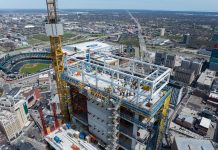
What is it?
A 29-story art deco masterpiece that anchors the New Center area, the Fisher Building endures as a symbol of the auto-infused affluence that characterized 1920s Detroit. Commissioned by the seven Fisher brothers and financed by their sale of Fisher Body Co. to General Motors in 1926, the structure was originally intended to be just one of three buildings along West Grand Boulevard. A mirror-opposite copy would have anchored the opposite end at Third Avenue, with both edifices bookending a majestic 60-story version in the center. The brothers saw the towers as a gift to the city that brought them remarkable success. Unfortunately, the arrival of the Great Depression forced the plan to be abbreviated. Today, the Fisher Building is a National Historic Landmark and is included in the National Register of Historic Places. Ground was broken on Aug. 22, 1927. Construction was completed just 15 months later.
Why is it in the news lately?
It’s for sale. After holding the Fisher since 2015 and investing some $24 million dollars in restoration work, the current managing partner, The Platform, reports that it has significantly boosted office and retail occupancy, while restoring the building’s place as a community focal point. The company feels that now is the time to pass the Fisher on to its next steward.
What’s special about it?
Most developers give their architects a budget to work within. Not the Fishers. They hired Albert Kahn and essentially gave him a blank check. The architect didn’t disappoint. Sumptuous appointments include 641 bronze elevator doors, 1,800 bronze window frames, and 325,000 square feet of exterior marble, making the building the largest marble-clad structure in the world. The bronze accents were added by Anthony DiLorenzo. At street level, a three-story, barrel-vaulted arcade sporting some 40 varieties of marble overwhelms the visitor, complemented by interior artwork (frescoes, mosaics, and sculptures) by Hungarian artist Géza R. Maróti. Interior plaster work and other sculptures were executed by Corrado Parducci. The theater was designed by Graven & Mayger. In total, the Fisher brothers spent a whopping $9 million on their project, equivalent to about $150 million today.
Who occupies it?
Perhaps the most noteworthy occupants are Albert Kahn Associates, the architectural firm responsible for the original design work, and The Christman Co., the corporate successor of the construction contractor. Retail tenants include The Peacock Room, Yama, The Fashion Place, and Shy vs Bold, stores offering women’s apparel. Dining options include Promenade Artisan Foods and Stella Good Coffee. Detroit Public Schools occupies five floors of the Fisher as its central office.
What’s it named for?
The legendary Fisher brothers. After learning the coach-building trade from their father in their native Norwalk, Ohio, the seven close-knit siblings moved north and established Fisher Body Co. in Detroit in 1908. Their names were Frederick J., Charles T., William A., Lawrence P., Edward F., Alfred J., and Howard A. Like other early pioneers of the auto trade, the brothers experienced phenomenal success as they capitalized on the golden age of the industry.
This story is from the June 2022 issue of Hour Detroit. Read more our digital edition.
|
|
|









